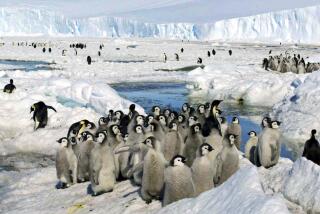Record Number of Penguin Eggs Thrills Sea World
- Share via
The world’s largest penguin colony outside of the Antarctic is on thebrink of getting even bigger.
Under lights designed to simulate springtime at the South Pole, Sea World’s 480 cold-weather penguins have paired off and produced a record number of eggs this year--103. Not far away, the marine park’s warm-weather Humboldt penguins, an endangered variety, are keeping a close watch on 20 eggs of their own.
Although park officials are reluctant to count a single chick before it hatches, they predict that, by Christmas, Sea World’s “Penguin Encounter” exhibit is likely to be awaddle with web-footed babies.
“Lord, help us,” Joop Kuhn, the exhibit’s supervisor of birds, said happily. “We’re going to have too many birds to name.”
Already, five chicks have hatched. Because each was one of two eggs laid by a single mother, all five are being hand-reared by Sea World keepers, fed on a steady diet of pureed herring and heavy cream. Using this method, aviculturists hope to help the penguin parents focus their attention on the remaining egg, increasing its chances for survival.
In past years, slightly fewer than half the eggs laid by the park’s penguins have hatched, with some species having better luck than others. The Adelie penguins seem to have no trouble reproducing before an audience in their glassed-in, 5,000-square-foot enclosure. Gentoo and macaroni penguins have caught on more slowly--the park’s first two captive-born gentoos were hatched in 1989.
Meanwhile, the chinstrap penguin, which is named for the black stripe across its neck, has never before been successfully bred in captivity. But park officials are cautiously hoping that will change. An examination of one of this year’s 15 chinstrap eggs indicates it is fertile and is due to hatch on Dec. 5. And more might be fertile as well.
Last year, only one of the eight chinstrap eggs was fertile, and it never hatched (it was DIS, Kuhn said: dead in shell). But, even if a chinstrap chick is not hatched this year, Kuhn said, he is encouraged by the increasing number of eggs (in 1989, there were four; in 1990 there were eight).
“We’re definitely moving in the right direction,” he said, consulting a hand-drawn chart that shows where in the exhibit each penguin pair is nesting.
The chart, called the war board, makes note of when and where each egg was laid, when it is expected to hatch and which penguins appear to be the parents. Kuhn explained that the chart’s name was inspired by what often happens when keepers enter the exhibit and try to gather the information they need from the protective parents.
“We have to pick them up, check the egg and mark it. They don’t like us to do that--hence the name,” Kuhn said, displaying scars on his hands left by the sharp beaks of the feathered parents.
“They fight dirty.”
More to Read
Sign up for Essential California
The most important California stories and recommendations in your inbox every morning.
You may occasionally receive promotional content from the Los Angeles Times.













